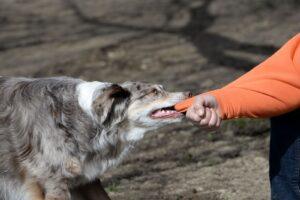
Dog Bite Risks in Kansas City
Toto, Copper, Buddy, Fido, Man’s Best Friend. On television and in movies, dogs are portrayed as loyal companions that will not leave your side or cause you harm. Dogs play a variety of roles ranging from napping household pets to the nose of a bomb squad. Dogs are smart creatures with incredibly honed senses. Police forces use them to sniff out dangers and drugs. The general public keeps them as watch guards or to hunt. In addition to assisting people with physical disabilities such as the visually impaired, dogs also serve as emotional support animals.
Today, dogs are permitted to go into public places with their owners. There may be a dog on the seat next to you on an airplane or walking next to you in the store. In many communities, there are even coffee shops and restaurants that are pet friendly—some even include dog treats on the menu. These relaxed rules increase the public’s exposure to dogs every day. This added exposure heightens the risk that you or your child will be injured by a dog.
Millions of people in the United States are bitten by dogs each year, with about half of those victims being children. According to the American Veterinary Medical Association, around 2.25 million children are bitten by dogs every year and about 450,000 of those children require medical attention. Top Kansas City dog bite lawyers discuss below.

Why Do Dogs Bite Children?
Dogs target children for a variety of reasons. For example:
- Children are more likely to be unaware of the dangers of approaching or touching an unfamiliar dog
- Children tend to be more playful with a dog, which may translate to the dog as being too rough while handling it
- Children are much smaller than adults, which makes them more vulnerable and easier targets.
Many dog bites occur in the child’s neighborhood, even with dogs the child might be familiar with and would otherwise have no reason to fear. Some studies show that certain dog breeds are more likely to be aggressive toward humans. However, in any given stressful situation, any dog can be dangerous.
A dog also may be aggressive because of the way its owners treat it. There are certain owner behaviors that tend to increase the likelihood of the dog attacking another human. These behaviors may include:
- Failure to properly train the dog
- Failure to supervise or monitor the dog
- Actively teaching the dog to be aggressive
- Neglecting to keep the animal on a leash when around others
Adults must educate children how to properly act around dogs. Also, it is essential for adults to take proper steps to mitigate a dog attack and know what to do if a child is actually harmed by a dog.
Contact our Kansas city personal injury lawyers now.

What Should I Do If A Dog Approaches My Family?
It is important to be aware of warning signs that a dog feels threatened and may pose a risk of hurting you or your child. A dog’s body language will let you know that it feels threatened and is preparing to attack. Some of these red flags include:
- Snarling or growling
- Rigid or tense body and limbs
- Stiff tail
- Pinned-back ears
- Visible teeth
- Intense stare
Even if you or your child are familiar with a dog, it is still very capable of attacking. When a dog approaches you and your child and exhibits any of the threatening signs above, remember the following:
- Remain calm. The dog and your child will respond to the way you act. Maintain your composure and handle the situation as calmly as you can.
- Do not make sudden movements. Running or waving your arms will only cause the dog to become more alarmed. As a result, the dog may react more aggressively or chase you.
- Do not scream or make loud noises. The additional stimulation will excite the dog and may cause an immediate, threatening response.
- Avoid eye contact. Staring at a dog can appear threatening or a challenge.
- Create a visual barrier. Put something between you and the dog, such as an umbrella, garbage can, blanket, purse, or bicycle to distract it.
- Pick up your child slowly. If your child is small enough and you are able, pick your child up off the ground. The dog will have restricted access to your child if they are in your arms. In this case, if the dog makes contact with your child, their head and neck will be further away from the dog’s reach.
- Instruct your child to curl into a ball. Doing this will protect your child’s vital organs and face from injury. The child should also cover the back of their neck and ears with their hands.
- Do not pull away if the dog makes contact. If a dog bites down and will not let go, do not pull away. Submit to the bite and lean into the dog. By trying to pull away, you pose a higher risk of serious injury or damage from tearing. Additionally, the dog may get bored from your lack of struggle and let go.
- Fight back if necessary. Fighting back should be the last resort, as this will likely escalate the situation. You can try to get the dog to back off by putting something over its face to disorient it or use physical force. If you must use force, try to target its soft tissue, such as its eyes or ears, to initiate a surrender.
Once the attack is over and the situation is under control, never turn your back to the dog.

What Steps Should I Take After My Child Is Hurt by A Dog?
When dogs attack children, the most common areas targeted include the child’s face, head, and neck. Children who fall victim to dog attacks may have to seek medical attention that includes stitches, rabies shots, and in the worst cases, plastic surgery.
If your child is attacked by a dog, you should take the following steps:
- Call 911 or seek medical attention. The high risk of rabies or infection following a dog bite is not something to ignore. Even if your child’s injuries appear minor, you should still seek medical attention immediately.
- Identify the dog owner. Find out who is in charge of the dog at the time of the attack. From the beginning, you will want to ask for proof of rabies vaccinations to avoid putting your child though painful and expensive shots. You also should obtain the dog owner’s information, which will be important for any potential legal proceedings you might pursue.
- Call animal control. This agency can apprehend the animal and file a report. This is an especially crucial step if there doesn’t appear to be someone with the dog at the time of the attack.
- Gather more information. Additional information may include any police reports that are made, documentation from animal control, any contact information for witnesses to the attack, and letters from the insurance company.
- Photograph your child’s injuries. Be sure to document your child’s injuries from the initial attack through every stage of the healing process.
- Journal about your child’s injuries and overall health. A dog bite claim may take years to complete. It is especially important during the weeks right after the attack to keep track of the difficulties and struggles your child may experience. After some time has passed, keep at least a weekly log of your child’s health until the case is completed.
- Contact the attorneys at Foster Wallace, LLC. The legal system is both complex and difficult to navigate for someone who is unfamiliar with it. The dog bite lawyers at Foster Wallace, LLC, will see your case to the end with your and your child’s best interests in mind. We will fight for justice for your child. You could be entitled to compensation that includes payment of medical bills or emotional damage.
- Keep all documents you receive or draft. Even if something seems minor at the time, it may be important to your case. It is critical that your attorneys have all the information available in order to properly present your case.
What Are Some Preventative Measures You Can Take to Avoid A Dog Attack?
It is beneficial to teach your child the potential dangers of dogs. Taking just a few preventative steps before a dog attack can save your child from a traumatic experience and painful physical injury. Talking with your child about these safety measures can save your family years of heartache and legal proceedings.
Educate your child about proper ways to behave around a dog, especially one they are not familiar with. A child should never approach a dog when it is eating or sleeping. This could cause a negative reaction from the dog. Additionally, children should never approach a dog from behind. A child should ask the dog’s owner if they can pet the dog before reaching out to it. Once an owner gives the child permission, they should pet the dog on its back instead of on top of its head.
Some other behaviors that children often do that irritate dogs include:
- Grabbing it by its tail
- Stealing its toys
- Teasing or taunting it
- Hitting it
- Riding the dog like a horse
A good practice as a parent is to actively supervise your child when they are near an unfamiliar animal. You do not know how a new dog will react to your child or whether the dog has a history of aggressive behavior.





